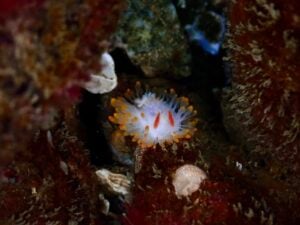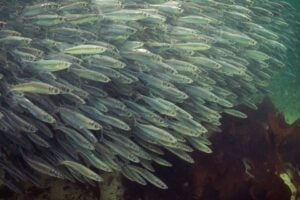Blue carbon refers to the carbon dioxide (CO2) captured and stored in marine ecosystems, such as salt marshes, seagrasses and kelp forests. These ecosystems capture and store atmospheric carbon in their organic material, making them crucial in mitigating climate change. In Canada, blue carbon ecosystems play a significant role in carbon sequestration and offer many ecological benefits.

Blue Carbon Ecosystems Explained:
Coastal wetlands, including salt marshes and seagrasses, are abundant along Canada’s coastline, the largest coastline in the world at 200,000 kilometres. Coastal wetlands and kelp forests store blue carbon in a process known as carbon sequestration, where plants and algae absorb CO2 during photosynthesis and store it in their tissues and the surrounding soil.
There are three main kinds of blue carbon ecosystems in Canada:
1 – Salt Marshes – Salt marshes are coastal wetlands found along the shorelines of estuaries, bays, and lagoons. As these plants grow upwards, they accumulate organic carbon in their roots, stems, leaves, and the surrounding sediment. If salt marshes are protected properly, they can store carbon for centuries or even millennia. In BC, 80% of all coastal and marine wildlife live at least part of their lives in salt marshes, even though they only make up 809 km2 of the province’s coastline. However, salt marshes are threatened by human activities. These threats include coastal development, such as urbanization, agriculture, and infrastructure projects; rising sea levels caused by climate change; pollution and run-off from agriculture, urban areas, and industrial activities; and habitat degradation from ditching, draining, filling, or altering natural water flows. Studies have found that 70% to 83% of BC salt marshes have been lost or degraded.
2 – Seagrass Meadows – Seagrass meadows are underwater flowering plants that form dense beds in shallow coastal waters. They are one of the most effective carbon sinks in the world, taking on 11% of carbon storage even though they make up just 0.1% of the ocean. In Canada, seagrass meadows can be found along the Atlantic and Pacific coasts, for example, within BC’s Strait of Georgia. These meadows are important habitats for marine organisms, securing shoreline stabilization, and improving water quality. Seagrass meadows face several threats and, in some places, have declined up to 50% since the 1930s. In Howe Sound, eelgrass, a type of seagrass, is threatened by shoreline development; commercial activity; residential and urban run-off and sewage; direct physical damage from activities, such as boating, anchoring, and land log booms; coastal forestry; and evasive species.

3 – Kelp Forests – Kelp forests store carbon at rates higher than terrestrial forests. The dense, fast-growing nature of kelp contributes to its efficient carbon capture and storage capacity, with kelp capable of growing 60 centimetres a day. Carbon is stored through photosynthesis and sedimentation. During photosynthesis, carbon dioxide is removed from the atmosphere, converted, and then stored in various parts of the kelp. Sedimentation occurs when kelp fragments sink to the seafloor, where they will most likely remain undisturbed forever. Therefore, this carbon is permanently sequestered. In B.C., kelp forests are prominent along the coast, though they are increasingly under threat due to pollution; warming water temperatures; and ecosystem disruption resulting in the overpopulation of species that graze on kelp, such as sea urchins.
Why is Blue Carbon So Important?
Defending and restoring blue carbon ecosystems on BC’s coast is essential. Even though salt marshes, seagrass meadows, and kelp forests cover a relatively small fraction of BC territory, they account for a disproportionately large amount of the province’s carbon sequestration, with blue carbon ecosystems being two to four times more efficient in absorbing carbon than terrestrial forests.

When left intact, blue carbon ecosystems act as carbon sinks, absorbing atmospheric CO2 and storing it in their biomass and sediment. When a blue carbon ecosystem is destroyed, however, all of its sequestered carbon dioxide is released into the atmosphere, contributing to global warming.
BC’s blue carbon ecosystems support rich biodiversity, providing vital habitats for many marine species, including fish, crustaceans, and birds. They also serve as important nurseries for commercially important species, contributing to coastal economies and livelihoods. When these vital habitats are destroyed, so are food systems and livelihoods. The economic security of coastal communities is intricately linked to healthy and thriving coastal wetlands.
Research
Researchers have been studying the carbon sequestration potential of blue carbon ecosystems and developing strategies to defend and restore them. These efforts aim to enhance carbon storage, preserve biodiversity, and maintain productive ecosystems for our children and grandchildren.
Organizations like WWF-Canada are working to understand and promote blue carbon’s significance. They are “advocating for policy-based protections, investing in strategic research and supporting the restoration of blue carbon habitats.” The WWF’s Blue Carbon Community is “bringing together scientists, policymakers, Indigenous knowledge holders and community organizations to build a nationwide blue carbon network to spark collaboration and accelerate conservation.”
The more we understand blue carbon and its importance, the better positioned we are to defend blue carbon ecosystems.
Coastal Wetlands and The Great Bear Sea
The Great Bear Sea is one of the most productive marine environments in the world. By including salt marshes, sea grasses, and kelp forests in the Great Bear Sea Marine Protected Area Network, these critical habitats will be fortified from threats. Defending these marine ecosystems will help maintain nurseries and feeding grounds for various species, sustain biodiversity, support fisheries, and enhance the overall resilience of coastal ecosystems. Without its coastal wetlands, however, the Great Bear Sea ecosystem will collapse.

The Opportunity for Carbon Offsetting
We need to focus on the benefits of blue carbon. However, we also need to be aware that industrial forces may exploit blue carbon for their benefit. In particular, industrial polluters might use blue carbon as an ‘offset.’ A carbon offset is used to balance greenhouse gas emissions in one place with carbon reductions or removals elsewhere. If blue carbon is exploited as an offset, industries could avoid the necessary emission reductions needed to combat climate change in sectors such as fossil fuel production, industry, agriculture, and aviation. We need to ensure that blue carbon is not treated as an offset; instead, blue carbon needs to be treated as carbon storage essential for reducing climate emissions.




